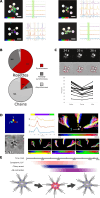Electrical signaling and coordinated behavior in the closest relative of animals
- PMID: 39772683
- PMCID: PMC11708886
- DOI: 10.1126/sciadv.adr7434
Electrical signaling and coordinated behavior in the closest relative of animals
Abstract
The transition from simple to complex multicellularity involves division of labor and specialization of cell types. In animals, complex sensory-motor systems are primarily built around specialized cells of muscles and neurons, though the evolutionary origins of these and their integration remain unclear. Here, to investigate sensory-behavior coupling in the closest relatives of animals, we established a line of the choanoflagellate, Salpingoeca rosetta, which stably expresses the calcium indicator RGECO1. Using this, we identify a previously unknown cellular behavior associated with electrical signaling, in which ciliary arrest is coupled with apical-basal contraction of the cell. This behavior and the associated calcium transients are synchronized in the multicellular state and result in coordinated ciliary arrest and colony-wide contraction, suggesting that information is spread among the cells. Our work reveals fundamental insights into how choanoflagellates sense and respond to their environment and enhances our understanding of the integration of cellular and organism-wide behavior in the closest protistan relatives of animals.
Figures





Similar articles
-
Aerotaxis in the closest relatives of animals.Elife. 2016 Nov 24;5:e18109. doi: 10.7554/eLife.18109. Elife. 2016. PMID: 27882869 Free PMC article.
-
The history of Salpingoeca rosetta as a model for reconstructing animal origins.Curr Top Dev Biol. 2022;147:73-91. doi: 10.1016/bs.ctdb.2022.01.001. Epub 2022 Mar 11. Curr Top Dev Biol. 2022. PMID: 35337467
-
Genome editing enables reverse genetics of multicellular development in the choanoflagellate Salpingoeca rosetta.Elife. 2020 Jun 4;9:e56193. doi: 10.7554/eLife.56193. Elife. 2020. PMID: 32496191 Free PMC article.
-
Choanoflagellate models - Monosiga brevicollis and Salpingoeca rosetta.Curr Opin Genet Dev. 2016 Aug;39:42-47. doi: 10.1016/j.gde.2016.05.016. Epub 2016 Jun 17. Curr Opin Genet Dev. 2016. PMID: 27318693 Review.
-
Selective factors in the evolution of multicellularity in choanoflagellates.J Exp Zool B Mol Dev Evol. 2021 Apr;336(3):315-326. doi: 10.1002/jez.b.22941. Epub 2020 Mar 21. J Exp Zool B Mol Dev Evol. 2021. PMID: 32198827 Review.
References
MeSH terms
Substances
LinkOut - more resources
Full Text Sources
Research Materials

